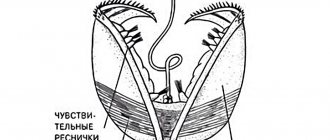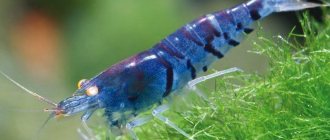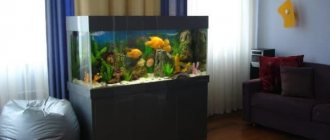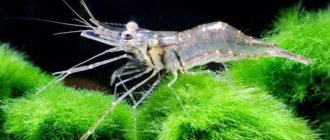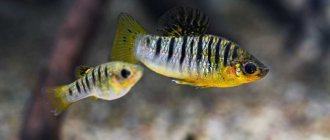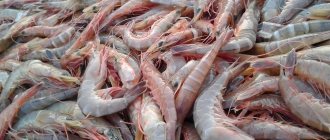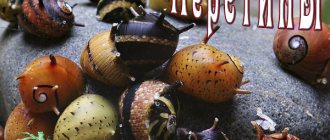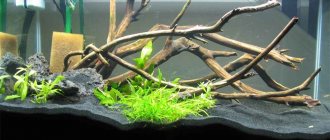The commercial shrimp or chilim or shrimp, unlike their fellow decapods, have adapted to life in the water column. This affected the structure of the shrimp.
The shrimp has an elongated body, while it is flattened on the sides. The body is divided into 2 main sections - the abdomen and the cephalothorax, which is almost half the length of the body.
Shrimp (Caridea).
At the beginning of the cephalothorax shell there is a pair of compound eyes located in special recesses.
Each eye is formed from a large number of facets, and their number increases with age. Facets separate age spots from each other. Each facet perceives only those rays that fall perpendicular to the cornea. Some facets see only a small part of the object that the shrimp is looking at, and the remaining parts are seen by other facets. That is, shrimp have mosaic vision. At night, the pigments diverge to the bases of the eyes, due to which oblique rays reach the retina, and the shrimp begins to see objects in full, but they are blurred.
Shrimp are ubiquitous in the seas.
The cephalothorax is protected by a durable chitinous shell, which is formed from two plates and attached to the gills. The lower part of the chitinous shell is soft and thin.
Shrimp have 19 pairs of limbs, all of which are responsible for certain actions. The antennae are used as organs of touch; with the help of the mandibles, the shrimp crushes prey, and it holds it with its jaws. Thin long legs, at the end of which there are small claws, play a special role - with the help of them the shrimp clean their bodies, they also insert these legs into the cavity of the toads and clean them if they are clogged. The remaining legs are used to move along the ground; they are longer and thicker in size than the other legs. The abdominal limbs are used during swimming.
The shrimp has an unusual appearance.
It is interesting to monitor the behavior of shrimp while snorkeling in the warm waters of the Sea of Japan. If you move the lush algae, the shrimp begin to jump out of them, like grasshoppers in a meadow.
The shrimp has a wide and strong caudal fin. Shrims bends him sharply and moves with thrusts. When the shrimp stops, it straightens its small oar legs under its tail and begins to quickly move them, swimming between the algae. In this case, the pectoral legs and antennae are pressed to the body. When a shrimp lands on algae and freezes, it moves its long antennae to the sides.
Chilims have orange legs. The eyes are violet. When the sun's rays pass through the shrimp's body, it shines through and gives off an emerald tint. The chilim reaches 18 centimeters in length. There are dark stripes along the body that serve to camouflage the shrimp among marine plants. Only when you get close can you notice the shrimp.
Shrimp is a very tasty delicacy.
If you lure a shrimp with a piece of meat or fish, they gather in small groups near the prey. At the slightest movement, they jump to the sides, while swimming away backwards, sharply bending their abdomen and pushing off the water with their caudal fin and abdominal legs.
Description
Shrimp are an infraorder of crustaceans from the order Decapods. Widely distributed throughout the seas of the whole world, many species have mastered fresh waters.
The size of adult individuals of different representatives varies from 2 to 30 cm.
Most of the colorful species on the market come from China, Japan, Southeast Asia and India. A large number of families and countless genera of shrimp live in the sea, some genera also inhabit fresh waters. The desire to obtain more colorful forms of shrimp has resulted in numerous breeding attempts and the search for new, brightly colored species. In turn, interspecific crossings and selection work have led to the fact that shrimp with extremely bright colors can now be found on sale in pet stores.
The structure of shrimp
They have a rather complex structure, especially expressed in a large number of legs, which in shrimps perform a wide variety of functions, from movement to breathing. The shrimp's body is divided into two main parts: the cephalothorax, on which the faceted eyes and most of the limbs are located, including antennae and walking legs, and the abdominal part, on which auxiliary limbs are located that help the shrimp when swimming and bearing young.
In these animals, three anterior thoracic segments are fused with the head, five pairs of hind legs are used for movement, the forelimbs are transformed into jaws, with which they carry food to the mouth. The head and chest are protected by the carapace, the gills are hidden under its edges. The limbs of the last segment of the abdomen have changed into wide plates that form a tail fan, thanks to which the shrimp can make sharp jumping swimming movements. The oral apparatus consists of well-developed jaws (mandibles) used for grinding food. The blade located on the jaws ensures the movement of water in the gills. The anterior end of the carapace is extended into a sharp awl-shaped rostrum (beak or nose). The abdominal legs (pleopods) are used for swimming, and in females, for bearing offspring. In males, the first pair of abdominal legs has transformed into a copulatory organ.
The eyes of shrimps are stalked and can turn in different directions, which provides a wide view. In search of food and shelter, shrimp use not so much vision as smell, touch and the “chemical sense”. These functions are performed by antennae. At the base of the antennae there is an organ of balance - a statocyst.
Organs of vision
The shrimp is an unusual animal that has different vision: day and night. Each of her eyes consists of a huge number of facets, and with age their number increases. The facet segments are separated by pigment spots. And each element perceives those rays that fall perpendicular to the cornea. Such vision can be called mosaic. It is characteristic that at night the pigments disperse to the base of the eyes, and oblique rays can reach the retina: the shrimp already sees objects in full, but their outlines are blurred.
Conditions for keeping shrimp in aquariums
Shrimp overgrown with algae
Shrimp molt regularly. During this time (two or three days before molting and one or two after it) they do not feed. Having freed themselves from the old shell, the shrimp take refuge in thickets of plants, under stones or in other shelters. After molting, their integument is soft, and for some time, until the shell becomes hard, the animals are defenseless. The shell is often eaten by shrimp - it contains minerals necessary for a new chitinous cover. After molting, shrimp recover damaged and lost limbs. In young people this happens faster, in adults it happens gradually, over two or three molts. By the way, some myths about shrimp are still worth dispelling 
Freshwater shrimp
Zebras examining pine cones
Freshwater aquarium shrimp are becoming increasingly popular among aquarists due to their interesting behavior and peaceful disposition. Small shrimp can be kept in small aquariums in the company of small fish.
Shrimp are very sensitive to oxygen deficiency, so the water must be aerated. They can live at temperatures from 15 to 30 °C. At 26-30 °C they are active, at 18 °C and below they become sluggish. Sharp fluctuations in water temperature in the aquarium are unacceptable.
A part of the aquarium that is densely overgrown with plants will serve as a refuge for the shrimp, and they will happily clean the snags, on which many tiny organisms usually live. The bottom soil in a shrimp aquarium should consist of gravel with a particle size of 3 to 5 mm, which allows a weak flow of water to penetrate into the soil and, accordingly, ensures good plant growth. It’s good if there is a lot of moss in the aquarium, especially Javanese. Moss provides shrimp with a large surface area from which they can eat microorganisms, and the sludge that accumulates under the moss serves as an additional source of food.
Since shrimp lead a secretive lifestyle, you can start a separate aquarium for observation and breeding - a shrimp tank.
Sea shrimp
Saltwater shrimp are also cleaners in marine aquariums. They are not very aggressive. The maximum aggression they are capable of is to fight with a similar shrimp using whisker swords. Many reef aquarium owners, having caught a shrimp dissecting the corpse of a dead fish or invertebrate, place all the blame on it, but this is nothing more than a misconception. Shrimp are aquarium orderlies, not killers.
Varieties for food
Shrimp meat, like most seafood, is rich in valuable iodine, which is necessary for the functioning of the thyroid gland. A huge amount of calcium, phosphorus, cobalt, iron and essential amino acids contributes to the stable operation and functioning of the most important systems of the human body.
There are usually three types commercially available: cocktail, tiger and king prawns. Of these, only the tiger (Penaeus monodon) is a separate species. The name cocktail shrimp is a purely commercial name, referring to any small specimens of these crustaceans that are usually intended for shrimp cocktail.
Most of the crustaceans sold in European stores are northern shrimp (Pandalus borealis), also known as Norwegian shrimp. Their mass collection at the beginning of the 20th century was started by the Norwegians.
The colder the water, the smaller the crustaceans look. But the “trifle” has a bright and rich taste. Often consumed by beer lovers boiled with spices, as an appetizer for a foamy drink. Several representatives live in the Baltic Sea, but due to the fact that they are small, they are used only as bait.
Of the many true crustaceans captured, three of the most important will be mentioned here:
- Sandfish (Crangon crangon) lives in European seas. It grows up to 9 cm. It is widely caught in the European part of the North Atlantic. In Europe, this species is most often eaten.
- The northern shrimp (Panduls borealis) lives in the cold waters of the North Atlantic. Caught in Canada, Norway and the environs of Greenland. Grows up to 16 cm.
- Black tiger is caught in the Indian Ocean and warm waters of the Pacific Ocean. The photo clearly shows huge individuals reaching 33 cm.
River (freshwater) specimens are deliberately excluded because they do not have much culinary value and are more used in aquariums.
The size (and therefore the price) is determined by the number of individuals per 0.5 kg. There are 15-18 pieces of giant ones, 25-30 pieces of large ones, 40-50 pieces of medium ones. The smallest shrimp, called gray shrimp, are also sold; they are no less tasty, very popular and much cheaper. The second important point is inedible heads. Crustaceans with heads of the same size will be much smaller than bellies with the same markings. Regarding whole shrimp, that is, with the head, the same numbers indicate the number of pieces per 1 kg. Conclusion: When you see the 16/20 symbol on the package, you can expect 16 to 20 whole shrimp.
Raw chopped seafood is found in Japanese sushi, while in other cuisines it is boiled and fried. They come in a shell with or without a head. The heads are useful and are used to make fish soup and shrimp sauce. On YouTube you can watch a video master class on grilling without spices. Peel and thread onto skewers (the clams should be large enough). They do not bake for long – about 2 minutes. In this form you can feel the taste of seafood. And only at the next stage is it recommended to familiarize yourself with the rest of the kitchen.
Adviсe:
- For grilling, it is better to use unpeeled crustaceans, then the meat will be tender and not too dry;
- wild cold-water shellfish are tastier than warm-water ones.
On Friday, after a hard week, it’s good to enjoy shrimp with wine, especially with garlic bread. Also good with rice. And the sauce is so tasty that you can eat it even without these twisted crustaceans.
Description of preparation. Action time: about 30 minutes.
Ingredients:
- 1 kg shrimp,
- 500 g tomatoes, peeled and pitted,
- 500 g grated carrots,
- 4 cloves of garlic,
- 1 chili pepper,
- ½ cube of butter,
- 1 glass of dry white wine,
- salt pepper.
Fry garlic and chili peppers in butter, add carrots and tomatoes, simmer for about 10 minutes. Add the shrimp, pour in the wine and simmer, uncovered, until the excess liquid has reduced and it’s ready.
Shrimp behavior
Shrimp are ideal for the aquarium. Small shrimps do not prey on fish or spoil plants, so they can be kept together with small peaceful fish species. Large fish regard small shrimp as a pleasant addition to lunch. When keeping shrimp and fish together, it is usually difficult to preserve any juvenile shrimp after the larval stage, including for species that breed in fresh water, since even the smallest fish readily eat the larvae.
In addition to small freshwater shrimp, large shrimp are also sold in stores. For example, Nigerian shrimp is a large filter feeder. But even such large shrimps have a peaceful disposition. However, there are exceptions, such as the Rosenberg shrimp and the chameleon shrimp.
Feeding
The basis for effective maintenance of aquarium shrimp is a competent selection of diet. In the case of arthropods, this is not difficult to implement. They feed on residues from plants and animals that are processed by bacteria. This could be rotten plant leaves or dead fish.
Video: Feeding shrimp
Aquatic insects, tubifex, bloodworms, and daphnia are also eaten. Shrimp prefer soft-leaved plants. However, feeding is necessary. Special dry food will help you care for these aquatic creatures. In addition, boiled vegetables are suitable.
It is enough to feed no more than once a day. At the same time, one day a week should be made a fasting day .
Shrimp are able to tolerate long breaks in feeding due to pasture.
Breeding shrimp in an aquarium
Newborn crystal in Eleocharis
The process of shrimp reproduction is very interesting. As noted, in the male the anterior pleopods were transformed into a special organ - the gonopodium. Having found by smell a female who molts before mating, he uses the gonopodium to attach spermatophores (sacs with sexual fluid) at her genital opening. A young male up to 8-10 mm in size can fertilize five females, while large older individuals (15-20 mm) can fertilize only one. The time interval between mating and laying eggs is from several days to two weeks. The eggs remain hanging on the female’s pleopods until the larvae hatch. At this time, she hides in a shelter.
During the breeding season, it is better to place shrimp in a separate aquarium, where the female calmly breeds her offspring. In a community aquarium it will be eaten by fish and other shrimp. Juveniles are very different from adults. It is very sensitive to unfavorable conditions and often dies.
Crossing shrimp is possible in some cases: see the compatibility table for shrimp species.
